This Baileys cake is a true show stopper. Three layers of rich, tender, Baileys-spiked chocolate sponge, sandwiched and topped with creamy, smooth Baileys buttercream. It's an absolute knockout.
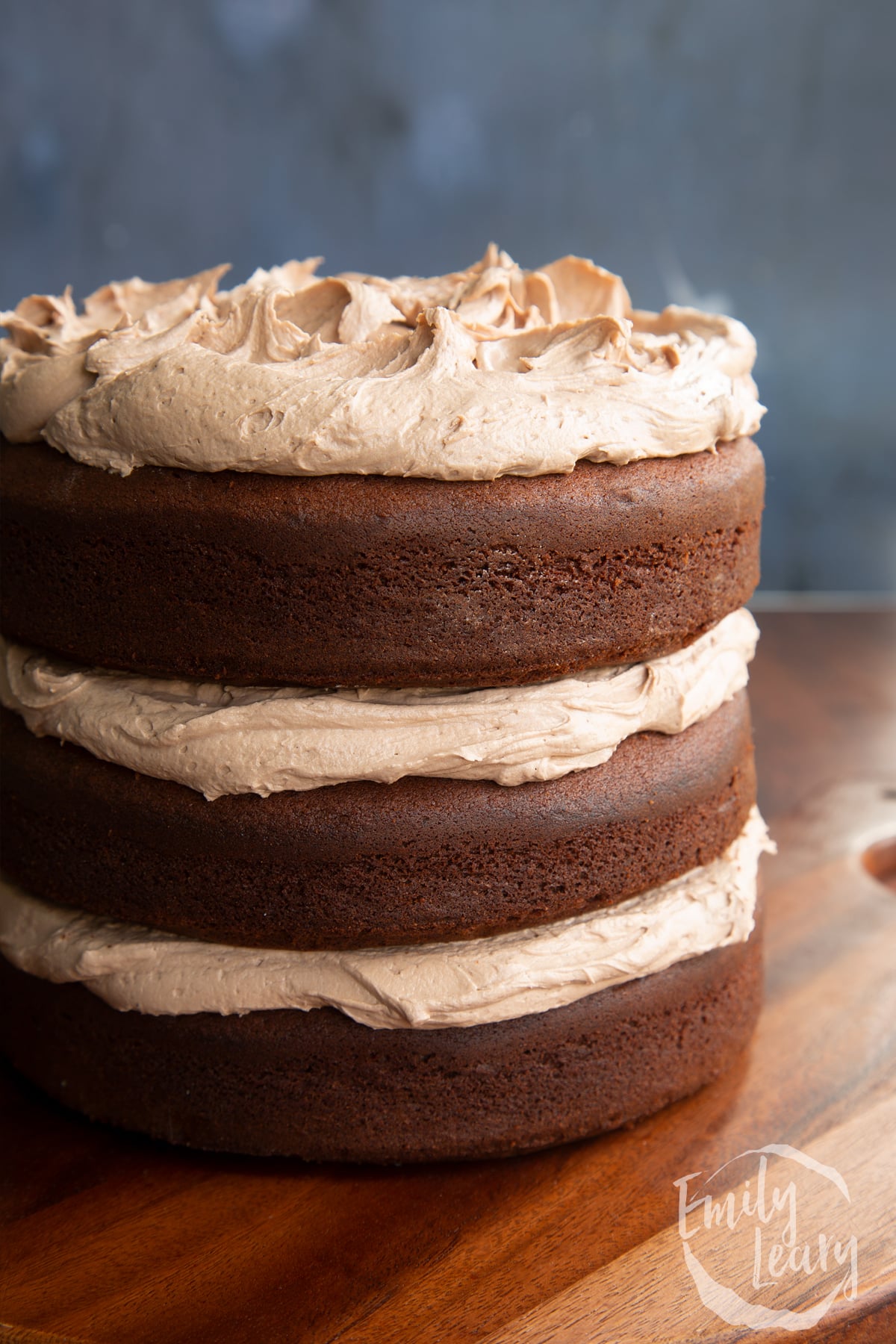
Making the sponge is easy. You'll start with the wet ingredients, whisking butter, vegetable oil, caster sugar and golden syrup together before introducing Baileys and eggs.
Finally, you'll fold in flour and cocoa powder, pout the batter into three lined tins and your intensely delicious cakes are ready to bake.
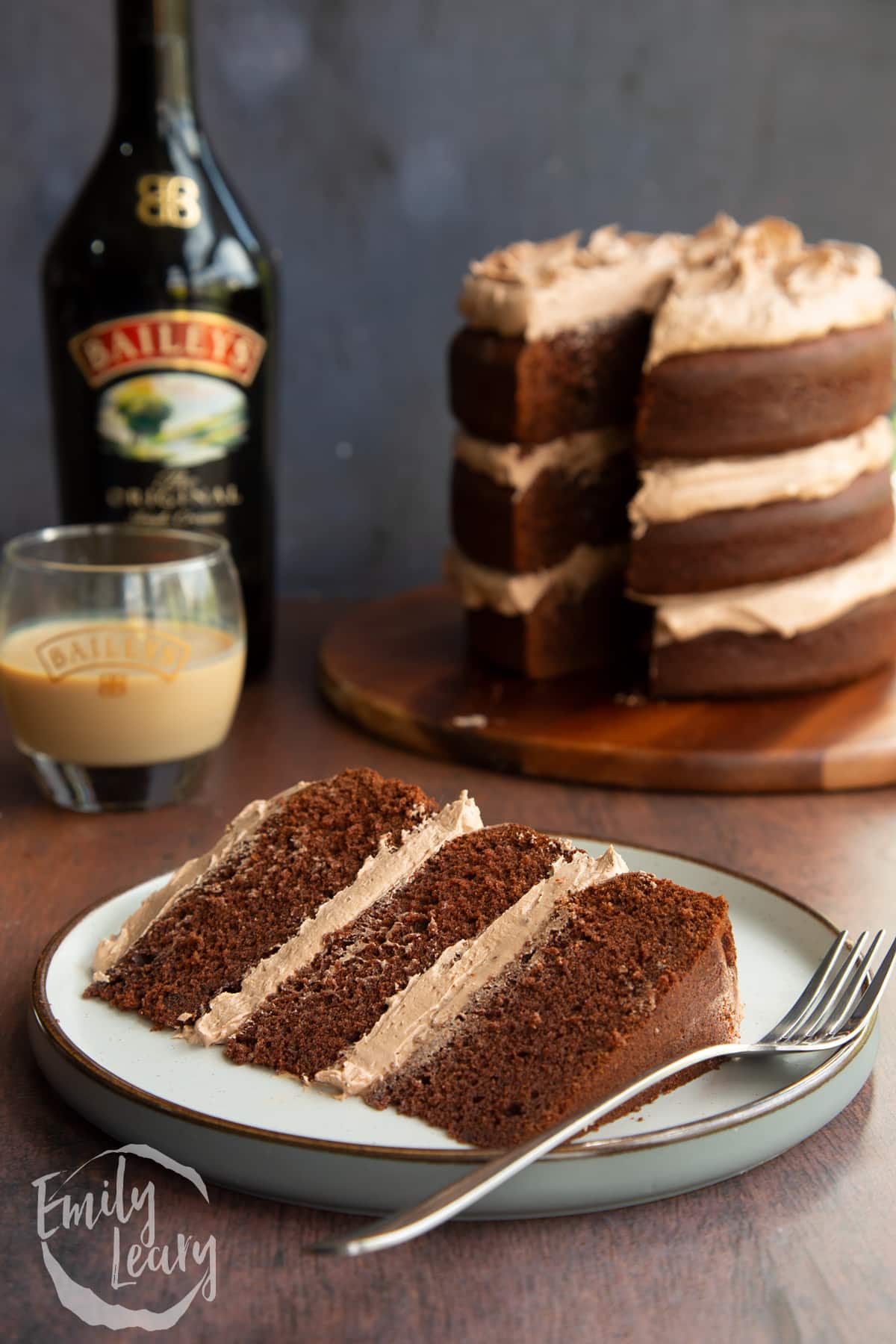
For the buttercream, you'll simply measure butter, icing sugar, Baileys and a touch of cocoa into a bowl and whisk together until pale, fluffy and light. A taste of this stunning Baileys buttercream will have you fighting with yourself not to eat it by the spoonful.

I think a centrepiece like this Baileys cake would be perfect for a grown up celebration, anniversary, birthday or dinner party. It would also be perfect to serve as a very special dessert for Christmas or New Years Eve.

Read on for the full Baileys cake recipe.
Ingredients
For the sponge
- 250 g (2 sticks + 4 tsp) salted butter
- 100 ml (⅓ cup + 1 tbsp) vegetable oil (canola oil)
- 325 g (1¾ cup) white caster sugar (superfine sugar)
- 75 g (4 tbsp) golden syrup US - use corn syrup
- 6 medium free-range eggs
- 400 g (2¾ cups) self-raising white flour (self rising flour)
- 80 g (⅔ cups) cocoa powder (dutch processed)
- 250 ml (1 cup) Baileys Original Irish Cream
For the Baileys buttercream icing
- 225 g (2 sticks) salted butter softened
- 560 g (4½ cups) icing sugar (powdered sugar)
- 75 ml (⅓ cup) Baileys Original Irish Cream
- 1½ tbsp cocoa powder (dutch processed)
Equipment
- 3 Round loose-bottomed 18cm (7") nonstick cake tin
Instructions
Grease and line three 18cm (7 inch) loose-bottomed cake tins.
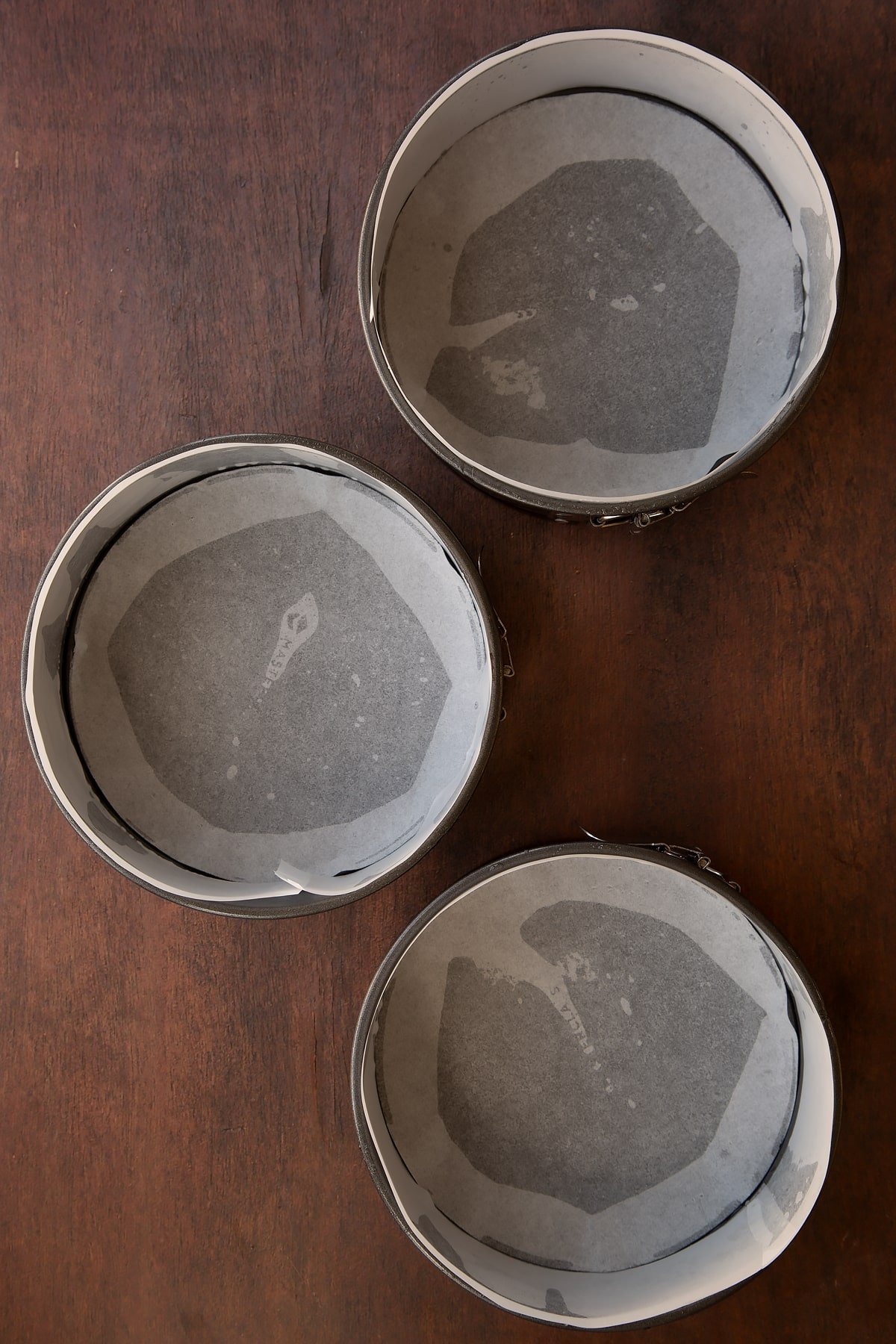
Preheat the oven to 180C (160C fan-assisted).
Make the cakes
Put the softened butter, vegetable oil, caster sugar and golden syrup in a large mixing bowl.

Beat them with an electric mixer or by hand until creamy.
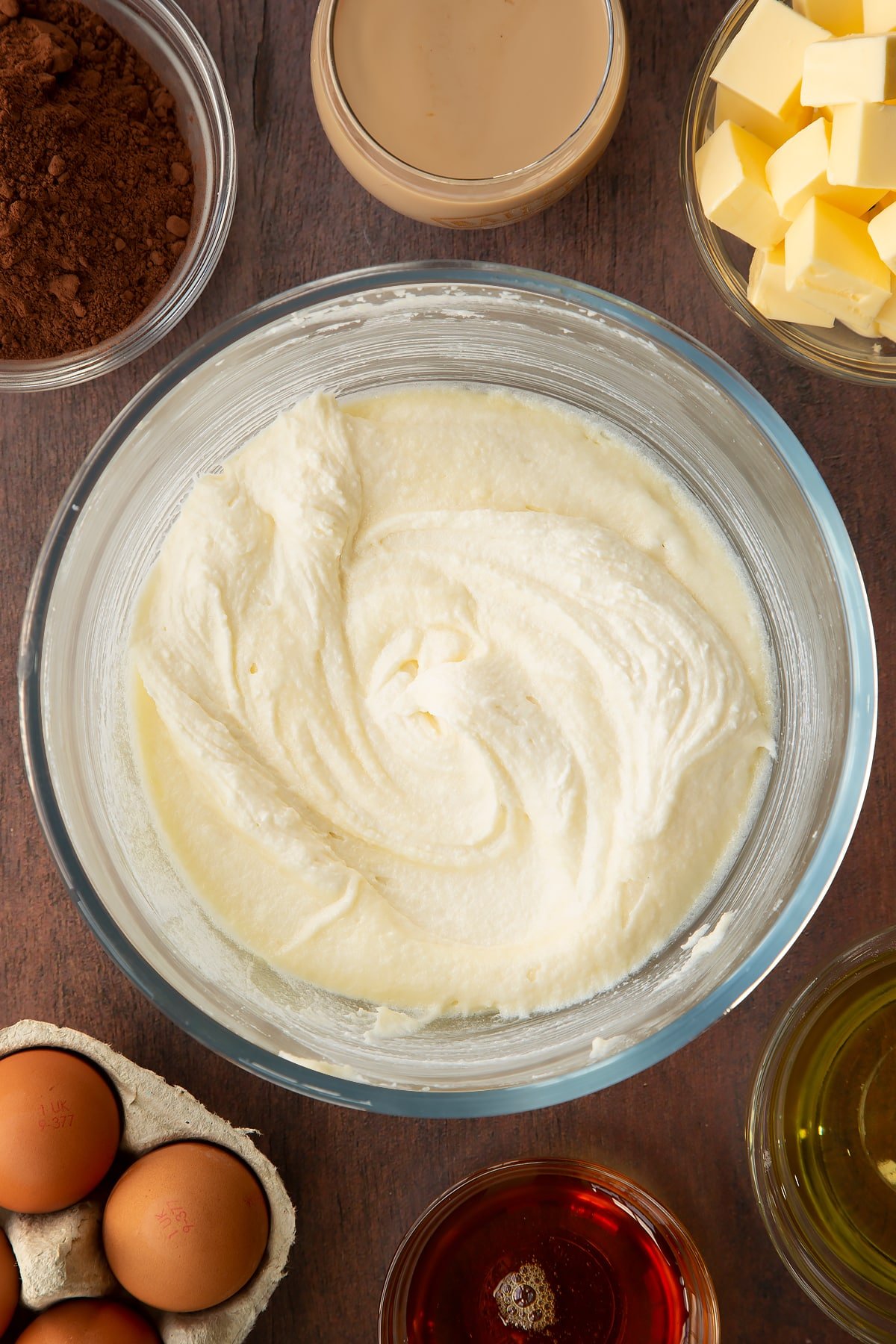
Add the eggs and Baileys.

Beat again until well combined.
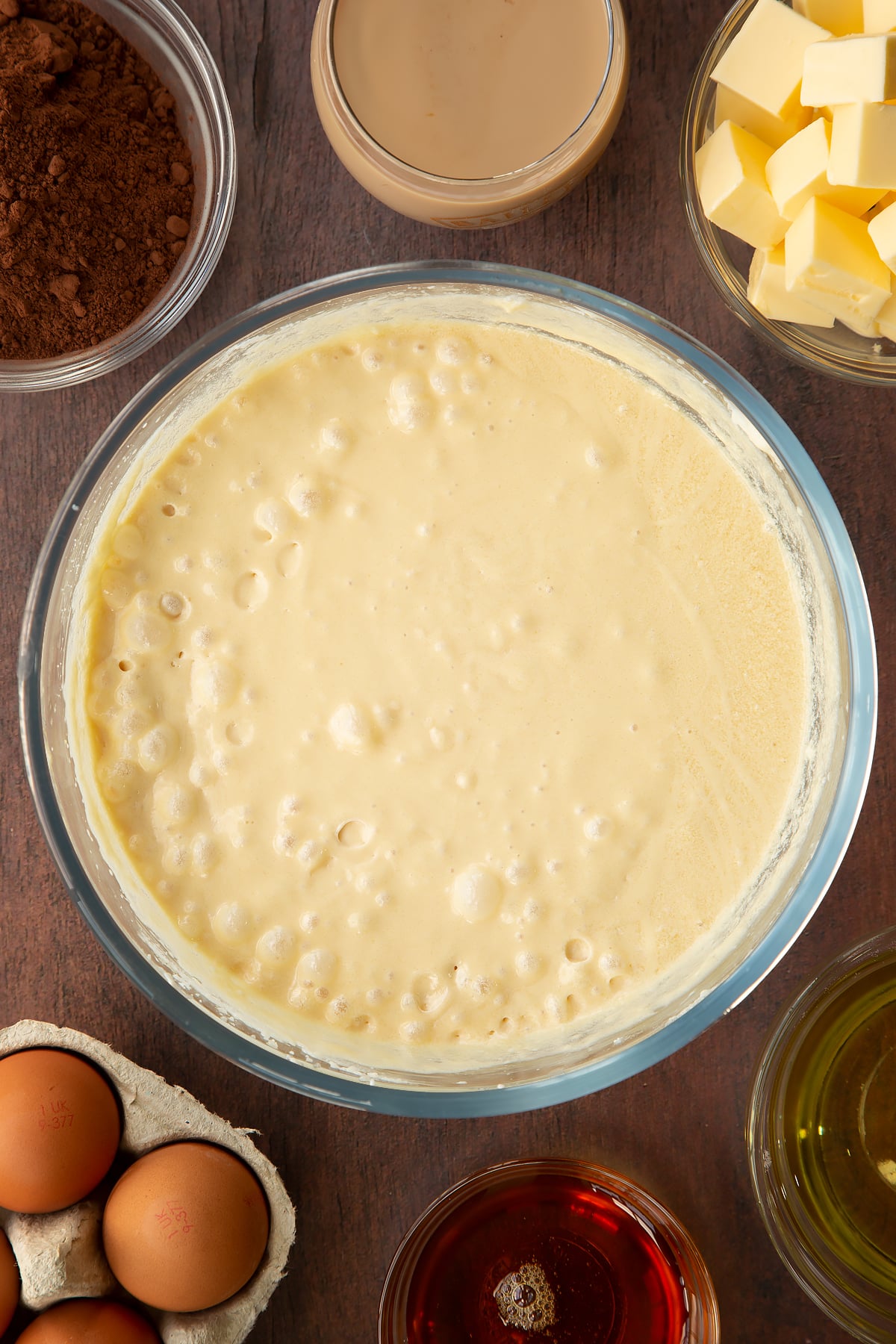
Sift in the flour and cocoa powder.

Fold everything together.

Divide the batter between the three lined cake tins and level off.

Bake in the centre of the oven for about 35-40 minutes or until risen and firm. A skewer pushed into the centre of the cake should come out clean. If there's a crack, test there as it tends to be where the the cake sets last.
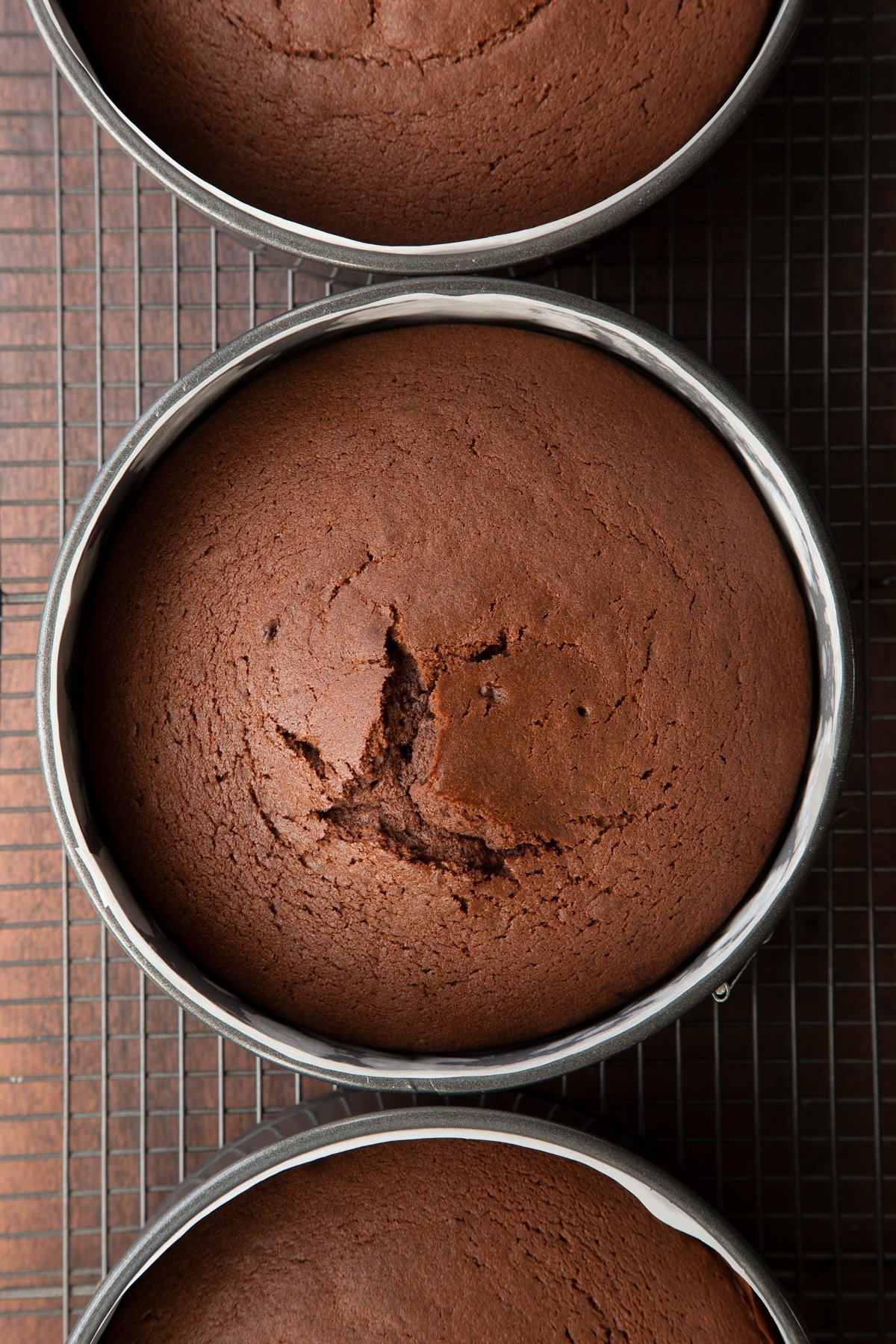
Allow your cakes to cool in their tins for 10 minutes, then release and transfer to a wire rack to cool completely.

Make the Baileys frosting
Put the softened butter in a large bowl.

Beat until smooth.

Sift in the icing sugar and cocoa powder. Pour in the Baileys.

Whisk until pale, fluffy and considerably increased in volume.

Complete the cake
When the cakes are totally cooled, trim the tops with a sharp serrated knife to level them off. Save the offcuts for a chef's treat!
Place one cake on a presentation board.

Spread a third of the Baileys frosting all over the top of the cake, right to the edges.

Place the second cake on top.

Spread a further third of the Baileys frosting on top.
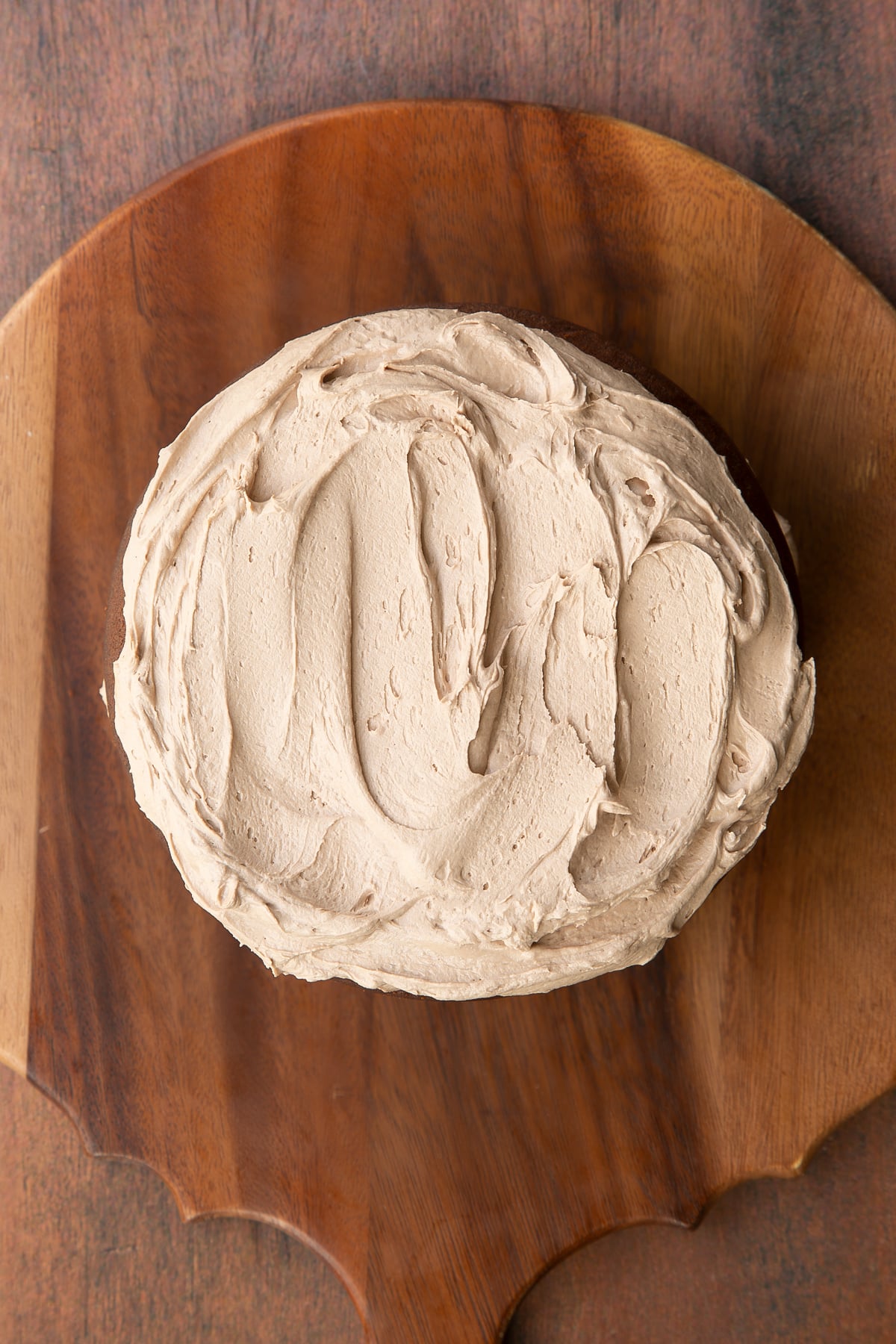
Add the third cake.

Spread the remaining frosting on top, swirling to give texture and height.

Isn't that beautiful?

Give the cake at least 15 minutes to settle before slicing and serving.

Enjoy!

Pointers, tricks and troubleshooting tips for the perfect Baileys cake
Is this Baileys cake easy to make?
This Baileys cake looks really impressive but it’s actually super simple, with a one-bowl sponge and one-bowl frosting recipe.
I’ve also included step-by-step photos above for every single step of the process, so you can see exactly the texture, colour or consistency you’re looking for at every step.
Will I need any special equipment to make this Baileys cake?
To make this recipe, you'll need measuring spoons, a large bowl, an electric mixer or whisk, a sieve, baking tins, baking paper, a cooling rack and a knife, which are all pretty standard baking equipment.
You'll probably find most of these things are already in your kitchen, but if you aren't a regular baker, you might need to pick up tins or a cooling rack, for example.
To help you, in the recipe card below (scroll down) I’ve included a full list of equipment along with links to buy them. All of the equipment is inexpensive, and you almost certainly be able to find them in your local supermarket too.
What is Baileys?
Baileys is an Irish cream liqueur made using cream, cocoa and Irish whiskey. It's a popular drink in the UK and is usually associated with Christmas, though you can buy it all year round.
I am not much of a drinker, but I love using Baileys in desserts or adding a shot to a creamy, comforting hot chocolate.
Where can I buy Baileys?
Baileys is available in most supermarkets and liquor stores that sell alcohol in the UK, Republic of Ireland, US, Canada, Australia and beyond. If you can't find it in-store, it's usually available on Amazon.
If you live in a country that doesn't sell Baileys, or want to use a cheaper off-brand alternative, you can always substitute it with a generic Irish cream liqueur. Try to pick one with real whiskey in it - the liqueurs that just contain ‘alcohol’ aren’t nearly as good.

How can I tell if my Baileys has gone bad?
Even though Baileys is made with fresh dairy, the alcohol content helps give it a long shelf-life of up to two years.
According to various unofficial sources, this applies whether the bottle is opened or unopened, and whether or not it has been kept in the fridge. However, I would recommend keeping your Baileys either in the fridge or in a cool cupboard and always with the lid firmly screwed on.
At the time of writing (October 2021) bottles of Baileys come with a Best Before date that is usually a year or more beyond the date of purchase. It’s worth noting that while Use By dates are essential safety markers and should never be exceeded, Best Before End dates are more indicators of the best quality, and so food can be safely consumed beyond that date, provided there are no signs of spoilage.
If you are worried your Baileys might have gone bad, first check the smell. A sour, unpleasant or unfamiliar odour is a sign that it has started to turn and should not be used.
Next, check the colour and texture by pouring a little into a glass. The liquid should be a light caramel colour. If it is darker, more akin to milky coffee, it has started to go bad.
The texture should be smooth and should pour and settle like cream. If there’s any sign of curdling or splitting in the liquid, then it should be discarded.
Finally, any change in taste is a sign that your Baileys is past its best and shouldn’t be used.
How can I tell if my eggs have gone off?
Eggs can stay fresh for weeks or go bad in days - it all depends on whether they’re stored properly.
In the UK, eggs are produced to a food safety standard called the British Lion Code of Practice and have a stamp on the shell of a red lion.
Eggs produced under the British Lion code must be stored at a constant temperature under 20C. In supermarkets, they can achieve this on the shelves, but at home, even cool kitchens are likely to fluctuate over 20C while cooking dinner, for example, so it’s important to store your eggs in the refrigerator.
For best practice when cooking, take just what you need from the box and leave the rest in the fridge to avoid temperature fluctuations.
In the UK, next to the British Lion stamp, you’ll see a Best Before End Date. If your eggs have been properly stored, they may be safe to use past that date as long as they show no signs of spoilage. However, if your eggs have a Use By Date, then they should not be eaten past that date even if they seem fine.
If you are worried your eggs might have gone off, fill a glass or bowl with cold water and gently add an egg. If it floats, this tells you that the egg is old enough for an air bubble to have formed within the shell, which happens as the contents releases water content.
Sometimes, eggs that float are still OK to use. You'll be able to tell if an egg is rotten as soon as you crack it open because it will smell horrendously sulfurous. Even a slightly off smell is enough to send an egg to the trash, and you should also discard if there's any discolouration.
If you have any concerns please speak to your health professional as this website does not offer medical advice.
Why did my golden syrup crystalise? Is it OK to use?
Golden syrup can be stored safely for years as it has such a high sugar content, and sugar is a natural preservative.
Golden syrup should be stored in a sealed container in a cool, dry cupboard. If it gets too cold, it may crystallise but this is harmless. If you gently heat the syrup in a clean pan over a low heat, it should become clear and smooth again. Allow the syrup to cool before returning to its original container, especially if it’s plastic. Be very careful as heated syrup can get extremely hot.
While crystals are fine, if you see any discolouration or strange-looking 'bits' within your syrup, you should discard it and use fresh golden syrup. If your syrup is in a tin rather than a squeezy bottle, be sure to use a very clean spoon to take what you need as contamination can result in bacterial growth.
Is this Baileys cake suitable for vegetarians?
At the time of writing (November 2021), Baileys is suitable for vegetarians so this Baileys cake recipe is vegetarian, as it contains no meat, poultry or fish products.
However, you should check all of your ingredients labels to make sure that they are suitable for vegetarians, especially if you're substituting elements of the recipe. Also, remember to check the labels on any sauces, custards or creams you choose to serve with the cake.
Is this Baileys cake suitable for vegans?
This Baileys cake recipe isn't vegan, but you can try to make it vegan by substituting some of the ingredients.
This recipe calls for butter and Baileys, which are made with dairy cow’s milk, as well as chicken eggs. However, many butter and egg alternatives are widely available in supermarkets or online.
For the butter, you can use vegan butter such as Flora Plant B+tter or Stork Baking Block. Dairy butter has a fat content of about 82%, so whatever brand you use, aim for one with similar fat content so that it behaves similarly in the sponge and buttercream.
For the eggs, there are a few options. These are the ones I most commonly use - each one is equal to 1 egg so you should multiply as appropriate to match the recipe.
- Store-bought egg replacement powder (use as directed on the packet).
- 1 tablespoon of crushed chia or flax seeds mixed with 2 tablespoons of water and left for 10 minutes in the fridge.
- 3 tablespoons of aquafaba.
- 3 tablespoons of applesauce.
- Half of a medium-sized banana, very well mashed. It’s best to use fairly ripe bananas for this as they will mash more easily and bind your ingredients together more effectively.
Traditional Baileys isn't vegan as it contains cream. However, you could try using Baileys Almande, which is made with almonds and should perform similarly.
If you adapt this recipe, you should check all of your ingredients labels to make sure that they are suitable for vegans, especially if you're substituting ingredients. Also, remember to check the ingredients for anything you serve with the cake.
Note: I have not tested all of these replacements with this particular recipe, so let me know how you get on.

Is this Baileys cake gluten-free?
This Baileys cake recipe isn't gluten-free as it contains wheat flour. However, you could swap in gluten-free flour and I suspect it would work well.
There are many wheat flour alternatives, though some lend themselves to cake baking more than others. For example, buckwheat flour is good for pancakes and biscuits but isn't suitable for cake baking as it doesn't rise well. Coconut flour is one of the more popular gluten-free alternatives but it can be dense and absorbent, so you would need to add extra liquid. You would also need to add gluten-free baking powder to help the cake rise.
The easiest option is to buy a shop-bought gluten-free self-raising flour that contains all the stabilisers and rising agents you need to help you bake a fluffy, gluten-free sponge.
The quality of gluten-free flour blends really varies and can affect the final result. The Free From Fairy makes some superb plain gluten-free flour, made from a blend of teff, sorghum, buckwheat, tapioca and potato flour. If going for this option, you’d just need to add 1 tsp of gluten-free baking powder for every 100g (3.5oz) of flour used.
As well as substituting the flour for a gluten-free option, you should carefully check the labels on all of your other ingredients to make sure that they're gluten-free. Equally, it's important to check the ingredients in any sauces or creams you use to serve or top your cake.
Is this Baileys cake keto-friendly?
This recipe includes quite a lot of flour and sugar, which means it is high in carbohydrate and not suitable for a ketogenic diet.
If you want to try and make a keto-friendly cake, there are baking ingredients like non-wheat flour or keto-sugar (sweeteners) available. However, this recipe might not be best for adapting to a keto diet as the Baileys (itself sweetened) is a key component.
Is this Baileys cake healthy?
This Baileys cake contains sugar and butter in generous proportions. As such, it should be enjoyed as an occasional, sensibly portioned treat as part of a generally healthy and balanced diet, rather than as an everyday meal.
Is this Baileys cake safe to eat while pregnant?
This Baileys cake contains a total of 325ml of Baileys, equivalent to about 20ml per slice, or 0.3 units per slice.
As of October 2021, the NHS advice on drinking alcohol during pregnancy is as follows: “Experts are still unsure exactly how much – if any – alcohol is completely safe for you to have while you're pregnant, so the safest approach is not to drink at all while you're expecting.”
There are some non-alcoholic Irish Cream liqueurs on the market. I haven’t tested them, but you try using them to replace the Baileys in this recipe.
The advice regarding egg safety for pregnant people varies from country to country, so check information local to you. In the UK, most eggs are produced under the British Lion code. At the time of writing (November 2021), the NHS states that British Lion eggs are safe to eat raw as there is such a low rate of salmonella. Check your eggs or the box for the British Lion stamp.
Any dairy used in this recipe should be pasteurised (most store-bought versions are, but always check the label). The NHS has a great explanation of why pregnant people should avoid unpasteurised dairy products.
You should always make sure that ingredients are in good condition and that you prepare your Baileys cake safely and hygienically.
A Mummy Too does not offer medical advice. Please seek help from a medical professional if you need further information or have any concerns.
What goes well with this Baileys cake?
With a creamy Baileys frosting and tender Baileys chocolate sponge, you don’t really need to serve this cake with anything else.
However, if you’re feeling particularly indulgent, you could serve it with single cream or even Baileys pouring cream. It would also be wonderful warmed briefly in the microwave (about 15-20 seconds) and served with cool vanilla ice cream.

Can I make this Baileys cake recipe without cocoa?
The cocoa in the sponge adds chocolatey flavour, of course, but it is also part of what balances out the batter properly to give a tender sponge, so I’m not sure how the cake would turn out without it.
If you would like to experiment with leaving the cocoa out of the sponge, I would recommend replacing it with flour in the same quantity so that the batter isn’t too wet.
Things are much simpler if you want to leave the cocoa out of the frosting. The cocoa is there to help bring out the Baileys flavour and give the frosting that familiar caramel hue we associate with the liqueur. However, it’s not essential to make the frosting work, so it’s fine to just leave it out.
I haven’t got golden syrup, can I use more sugar instead?
The golden syrup in this recipe helps give the sponge a light, bouncy, tender texture, but if you don’t have any, it’s fine to replace with the matching weight in sugar.
Can I add extra Baileys to this recipe?
The Baileys quantities in this recipe have been carefully tested to ensure the final sponge and buttercream turn out perfectly. For this reason, I wouldn’t recommend adding extra.
However, you can serve the cake with some Baileys pouring cream and a glass of Baileys, of course. I’m also rather partial to Baileys chocolates, which you could use to garnish the top of the cake, if you wish.
How should I store Baileys cake?
If you somehow have any leftovers of this delicious Baileys cake, it's safe to store it in an airtight container in a cool dark place.
However, as it’s a three-tiered cake it’s quite tall, so it might be easier to store individual slices if you're low on space. You could layer slices in an airtight container, and in between sheets of baking parchment to stop the pieces from sticking together.
How long does Baileys cake keep?
This Baileys cake has a delicious and creamy frosting made from buttercream.
This means it's best to keep the cake in the fridge, where it will keep for 3-5 days.
Can I leave Baileys cake out on the counter?
No, if you leave your cake out on the counter, the butter in the frosting might spoil. So, it's always best to store your cake in an airtight container in the fridge.
Can I make Baileys cake ahead?
Yes, you can make the cake elements in advance and assemble them when you want to serve your Baileys cake.
You can make the sponges whenever you like and freeze them in advance. Just make sure to defrost them overnight, so you aren't serving a cold cake!
You can make the buttercream frosting in advance as long as you store it in an airtight container in the fridge. Some sources recommend keeping buttercream for up to two weeks, others for up to five days.
As long as your butter is in date and is stored correctly, keeping your buttercream for two weeks should be fine. However, it's always safest to use fresh buttercream.

Can I keep Baileys cake in the refrigerator?
Yes, ideally, you should keep any leftover cake in an airtight container in the fridge. You can keep the cake intact if you have a big enough container. Or you could store individual slices layered in lunchboxes with baking paper between each layer to stop the pieces from sticking together.
Can I freeze Baileys cake?
Yes, you can freeze Baileys cake. However, it's best to freeze individual slices rather than the whole cake so you can defrost slices as needed.
An easy way to store your slices is to layer them in between sheets of baking paper in an airtight and freezer-safe storage container.
It's best to snugly fit the slices within a container so that there's less air; this helps prevent freezer burn (the frosty layer that appears on frozen food sometimes).
Baileys contains cream, which isn't ideal for freezing as it can separate. So your icing might not look its best once defrosted, but don't worry, it'll still be delicious!
What is the best way to defrost Baileys cake?
Defrosting a slice of Baileys cake is very easy. Just lay it on a covered plate or put it in a container and defrost it in the fridge for a few hours.
Defrosting in the fridge is always best as it helps your food consistently defrost, rather than the outer layer defrosting quicker.
The icing may separate a little due to the cream in the Baileys, but it will still be edible and taste just as great.
Can I make this Baileys cake in a different size/quantity?
Yes. If you’re having a big get together or want a smaller cake you can adjust the recipe size.
In the recipe card below, you'll see the servings near the top left. You can change the number of servings (slices) to the amount you prefer. Just click on the serving size number, and a little slider will pop up. Then you can move the slider up or down to get the amount you want to make.
All the ingredient quantities will update automatically for you so that everything is in the correct ratios.
If you change the size of your cake, you need to think about the size of your cake tins. If you make smaller cakes you'll have a thinner layer of cake mix in the 7 inch tins, so you might want to use smaller tins. You'll also need to reduce the temperature or cooking time for a smaller sponge cake. Equally, you'll need to increase the temperature or cooking time for a thicker sponge cake. Many people reduce or increase the temperature by 25F, add or reduce cooking time by a few minutes, and monitor the cake as it bakes. The skewer test will let you know if your cake is cooked to the centre.
As this is a layered cake, you could use the same sized cake tins, oven temperature and cooking time, and only make one or two layers of sponge. If you make fewer layers of sponge cake, just remember to make less buttercream frosting.
Can I make this Baileys cake in individual portions?
In theory, yes you can, though I haven’t tested the cooking time for a single portion. One way to do it could be to make Baileys cupcakes. I have a Baileys chocolate cupcake recipe here. You could slide the portion size on the recipe card to '1 cupcake', and it will give you the correct ingredient measurements.
Can I make this Baileys cake in a different tin/tray?
You can make your Baileys cake in any shape or size tin you want, as long as you grease and line it, and there is room for the batter to rise as it bakes. However, I haven't tested every shape or sized tin, so you'll have to use a bit of judgement if you use a different shaped tin.
Keep in mind that changing the tin size or shape could change the cooking time, so keep an eye on your cake as it bakes.
If you use a different shape or sized tin and are unsure if it's cooked through, you can do a skewer test by poking a skewer or knife into the centre. If it comes out clean with no batter, then your cake is cooked through.
Can I make this Baileys cake in a stand mixer such as a KitchenAid or Kenwood Mixer?
Yes, you'll need to cream (mix) your butter and sugar with an electric mixer. Of course, you can do everything manually, but it might feel more like a gym session than a baking session.
Can I make this Baileys cake with a food processor?
You could mix your ingredients with a food processor, but make sure not to mix your flour too much. Overmixing flour can affect gluten, which makes for tougher cakes. Just blend the ingredients enough that they're combined well with no lumps.

How can I make sure my Baileys chocolate sponge is perfectly cooked?
Even when you follow a recipe to the letter, a temperamental oven or ingredient can affect your bake. But don't worry, there are a couple of ways you can make sure your cake cooks perfectly.
Does it look 'set' and dry, all the way to the middle? If it still looks wet and unrisen, it isn't cooked. If it looks cooked, but you aren't sure, you can gently press your finger into the centre. If it feels slightly springy, it may be cooked, and if it leaves an indentation, then it's not ready. When you think your cake is cooked, push a clean skewer or thin knife into the centre of the cake. If your cake is ready, it should come out completely clean (no batter clinging to the blade).
So whether you've used this recipe or you've used a different quantity of ingredients or shaped tin, as long as it passes these tests, you're good to go.
How can I get perfect Baileys buttercream?
To make perfect Baileys buttercream, you need to make sure your butter is beaten until smooth. So there should be no lumps by the time you add your sugar and cocoa powder.
When you add your dry ingredients, make sure you sift them first to reduce the chance of lumps and again, make sure it's beaten until smooth. Gradually adding the dry ingredients as you mix will help make it easier to mix.
You can also gradually add the Baileys to your buttercream, making mixing less messy and easier to control.
Why did my Baileys cake sponge turn out dry/hard/burned/overcooked?
There are a few reasons why your cake might have overcooked or dried out.
Many household ovens have inconsistent temperatures, so your oven could be running hotter than it says. Unfortunately, unpredictable oven temperatures are a widespread problem, so if you do a lot of baking, I'd recommend getting an oven thermometer so that you can accurately see how hot your oven gets. Baking isn't very forgiving when it comes to temperature, so it's important to make sure you're cooking at the right temperature.
It's also essential to follow recipe quantities carefully. Baking can be easy when you follow the recipe, but things can go wrong quickly when the ingredient ratios aren't correctly balanced. For example, if your batter is too dry and thick or has too much liquid, your cake might be flat or too dense. Too much sugar or syrup could also toughen your cake.
The last half to a quarter of the baking time is where your cake can burn or get dry, so keep an eye on it then so that you can spot when your cake is ready.
Why did my Baileys cake sponge turn out wet/soft/undercooked/dense?
If your cake is taking longer than the recommended cooking time, your oven might not be as hot as its dial suggests. Investing in an oven thermometer can help you accurately see how hot your oven gets. But don't worry. You can still cook the sponges for longer on a lower heat, and they should be fine.
It could be that the ingredient quantities were incorrect, which might happen if you're converting the measurements. So make sure to follow the recipe carefully as too much liquid or too little flour can result in a thin batter, making your cake undercooked or dense, and too much oil can result in a greasy cake.
Alternatively, if you're keeping an eye on the clock rather than using a timer, it might just be a simple human error, so it's always best to set a timer.
If you're unsure if your cake is cooked through, you can always make sure to test your bake by looking, touching and using a skewer as described above. It's always best to do these tests before you finish cooking a cake.

Why didn’t my Baileys cake sponge rise?
There are a few reasons why your cake didn't rise. It could be related to your ingredients, the mixing method and the oven. Here are some of the most common causes of a cake not rising:
Your raising agents might be old. Self-raising flour, baking powder and bicarbonate of soda remain effective for months or even years, but if they've been sitting in the back of the cupboard for a while, they may have lost their potency, especially if opened. If you're noticing that your bakes are falling flat, you should invest in some new ingredients.
If your ingredients are all new and in date, the issue might be with overmixing the batter. It's crucial not to over mix your cake batter when you've added flour, as this can over-activate the gluten, making your cake denser and tough.
Why did my Baileys cake sponge sink in the middle?
Once your cake is in the oven, you shouldn't open or bang the door for roughly the first half of the cooking time. This is because opening the oven too soon can make the cake collapse or stop rising.
Your cake is rising because bubbles are forming in the batter. These bubbles set and create the sponge texture of a cake. However, if you open or slam the oven door before the bubbles set, they'll pop, and your cake could sink in the middle.
Why did my Baileys buttercream taste grainy?
Your buttercream might be grainy because you haven't used icing sugar (or powdered sugar). If you use granulated or caster sugar, you won't get a smooth buttercream because the sugar crystals are too big, so make sure you use the right kind of sugar.
Equally, you might have a lumpy or grainy buttercream because you didn't sift the cocoa powder or sugar. Siting dry ingredients can help reduce lumps or break them down, so sifting is key if you want a smooth frosting.
Why couldn't I taste the Baileys in this cake?
If you followed the recipe exactly but used a Baileys alternative (like a supermarket's own brand), maybe the alternative's flavour isn't as strong as real Baileys. Or, if you've used an unfamiliar brand or type of cocoa powder, it could be a stronger version than other brands or varieties, and the cocoa powder has overpowered the Baileys.
How can I add/change the flavours in this Baileys cake?
Baileys is a Christmas tradition in many households, so you could make this a festive favourite by adding seasonal spices like cinnamon, nutmeg, ginger and even ground cloves. Or you could try swapping out Baileys for Kahlua for a more coffee flavoured liqueur.

Print this Baileys cake recipe
Baileys Cake Recipe
Ingredients
For the sponge
- 250 g (2 sticks + 4 tsp) salted butter
- 100 ml (⅓ cup + 1 tbsp) vegetable oil (canola oil)
- 325 g (1¾ cup) white caster sugar (superfine sugar)
- 75 g (4 tbsp) golden syrup US - use corn syrup
- 6 medium free-range eggs
- 400 g (2¾ cups) self-raising white flour (self rising flour)
- 80 g (⅔ cups) cocoa powder (dutch processed)
- 250 ml (1 cup) Baileys Original Irish Cream
For the Baileys buttercream icing
- 225 g (2 sticks) salted butter softened
- 560 g (4½ cups) icing sugar (powdered sugar)
- 75 ml (⅓ cup) Baileys Original Irish Cream
- 1½ tbsp cocoa powder (dutch processed)
Equipment
- 3 Round loose-bottomed 18cm (7") nonstick cake tin
Instructions
- Grease and line three 18cm (7 inch) loose-bottomed cake tins.
- Preheat the oven to 180C (160C fan-assisted/350F).
Make the cakes
- Put the softened butter, vegetable oil, caster sugar and golden syrup in a large mixing bowl. Beat them with an electric mixer or by hand until creamy.
- Add the eggs and Baileys. Beat again until well combined.
- Sift in the flour and cocoa powder. Fold everything together.
- Divide the batter between the three lined cake tins and level off.
- Bake in the centre of the oven for about 35-40 minutes or until risen and firm. A skewer pushed into the centre of the cake should come out clean. If there's a crack, test there as it tends to be where the the cake sets last.
- Allow your cakes to cool in their tins for 10 minutes, then release and transfer to a wire rack to cool completely.
- Make the Baileys frosting
- Put the softened butter in a large bowl. Beat until smooth.
- Sift in the icing sugar and cocoa powder. Pour in the Baileys. Whisk until pale, fluffy and considerably increased in volume.
Complete the cake
- When the cakes are totally cooled, trim the tops with a sharp serrated knife to level them off. Save the offcuts for a chef's treat!
- Place one cake on a presentation board. Spread a third of the Baileys frosting all over the top of the cake, right to the edges.
- Place the second cake on top. Spread a further third of the Baileys frosting on top.
- Add the third cake. Spread the remaining frosting on top, swirling to give texture and height.
- Give the cake at least 15 minutes to settle before slicing and serving.
Video
Nutrition
Pin this Baileys cake recipe

More Baileys recipes to try
Have you got my book?

'This is a great kids cookery book. Emily is a star' - Simon Rimmer
'The book I'd like to force into any mother's kitchen' - Prue Leith
"A fab book with a plan." - Jane Devonshire, 2016 Masterchef UK winner
'Emily has managed to combine her mummy knowledge and passion for food to make a truly helpful and brilliant cookbook' - Priya Tew, RD, BSc (Hons), Msc
Get Your Kids to Eat Anything is an achievable 'how to' for parents in the battle to overcome picky eating and 'make new the norm'. Emily Leary's unique 5-phase programme looks at the issue of 'fussy eating' in a holistic way that links imagination with food, and which situates parents alongside - not in opposition to - their children.







Leave a Reply